Vibration Reduction Characteristics and Vibration Control of Aviation Hydraulic Pipeline by Hard Coating
Abstract
:1. Introduction
2. Materials and Methods
2.1. Selection and Preparation of Experimental Materials
- (1)
- YSZ (8%Y2O3-ZrO2) coatings. In engineering practice, when YSZ powder hits the surface of the substrate in a molten state through atmospheric plasma spraying, it spreads and forms lamellae. With the continuous accumulation of the lamellar structure, a hard YSZ coating with interlayer pores, spherical pores, and microcracks is formed, which has excellent thermal shock resistance. The YSZ coating could significantly improve the damping performance of the substrate, though the substrate temperature and evaporative beam can affect the damping performance by changing the microstructure of the coating [22]. An agglomerated YSZ nanopowder (Beijing Chemical Company, Beijing, China) produced by a company in Beijing was selected as the raw material for preparing the coating.
- (2)
- YSZ–PTFE composite coating. PTFE is a high-molecular-weight polymer with an excellent low loss tangent and stable dielectric constant. In engineering practice, PTFE is filled with ceramic fillers to change its material properties and can be used as a damping material to gradually attenuate the incoming vibration energy, thereby realising vibration reduction and noise reduction. The PTFE composite material was coated on the surface of rolling bearings to test its main mechanical properties and damping, and the results showed that PTFE can be used in the field of vibration reduction [23]. PTFE powder produced by a chemical company in Fuxin (Fuxin Chemical Company, Fuxin, China) was selected.
- (3)
- Al–Cu–Fe–Cr quasicrystal coatings (Beijing Chemical Company, Beijing, China). These are a kind of intermetallic compound with a structure between periodic and disordered, and they have the properties of high hardness, a low friction coefficient, and low thermal conductivity. Because of their inherently high brittleness, they are usually prepared on the surface of substrates as a thermal barrier coating. In view of the special properties of quasicrystalline coatings, Professor Chungen Zhou used low-pressure plasma spraying to prepare Al–Cu–Fe–Cr quasicrystalline coatings on Ti alloy substrates and found that they have vibration-damping properties. The selected quasicrystalline powder material was an Al–Cu–Fe–Cr ternary quasicrystalline alloy.
2.2. Experimental Design
2.3. Atmospheric Plasma-Spraying Equipment and Hard-Coating Preparation Process
- (1)
- Control cabinet. This is mainly used to control the various gases, such as argon, hydrogen, and powder gas, and the spray-gun cooling water transmitted during the spraying process. Various parameters in the spraying process can be adjusted in real time to protect the normal operation of the equipment.
- (2)
- Spray gun. This is composed of a gas pipeline, a powder feeder, a cathode, and an anode. The spray gun can form a high-temperature and fast atmospheric plasma arc.
- (3)
- Powder feeder. This controls the storage, supply, delivery rate, and particle size of the coating powder.
- (4)
- Robotic arm. An IRB52 industrial robotic arm produced by ABB in Switzerland was used.
3. Finite Element Model of a Hard-Coated Straight Aviation Hydraulic Pipe
3.1. Establishment of the Finite Element Model
- (1)
- Simplified modelling of a straight pipe
- (2)
- Simplified modelling of a hard coating
3.2. Material Parameters
3.3. Mesh Segmentation
4. Finite Element Analysis of the Hard-Coated Straight Aviation Hydraulic Pipe
4.1. Modal Analysis of the Hard-Coated Straight Aviation Hydraulic Pipe
4.2. Simulation-Based Harmonic Response Analysis of the Straight Aviation Hydraulic Pipe
5. Harmonic Response Analysis of the Straight Aviation Hydraulic Pipe Based on Experimental Testing
5.1. Experiment to Determine the Low-Pressure Fixed-Frequency Harmonic Response of Engine Double Rotors
5.2. Experiment to Determine the High-Pressure Fixed-Frequency Harmonic Response of Engine Double Rotors
5.3. Analysis of Experimental Results
Analysis of Orthogonal Experimental Results of the Constant-Frequency Excitation of High- and Low-Voltage Rotors
5.4. Comparison between Simulation Results and Experimental Test Results
6. Conclusions
- (1)
- From the simulation study of a straight aviation hydraulic pipe, performed by finite element analysis, it was concluded that different coating thicknesses, coating materials, and pipeline materials have different degrees of influence on the natural frequency and the displacement of the main mode shape. As the coating thickness increased, the natural frequency offset increased, and the displacement of the main mode shape decreased. The maximum offset of the first-order natural frequency was 7.5%, and resonance could be prevented by changing the natural frequency. The maximum displacement of the main mode shape displacement was reduced to 16.28%, indicating that the hard coating could effectively suppress the vibration of the pipeline under the basic excitation of normal working conditions.
- (2)
- A vibration response analysis of the hard-coated aviation hydraulic pipeline under the constant-frequency simple harmonic excitation of the high- and low-pressure rotors was carried out using an orthogonal experimental design. The results showed that of the three influencing factors (hard-coating thickness, pipeline material, and hard-coating material) under high- and low-pressure constant-frequency excitation, the coating thickness had the greatest influence, and the greater the coating thickness, the lower the pipeline vibration response. The influence of the hard-coating material was the second most influential factor, and the pipeline material was the least influential.
- (3)
- According to the orthogonal experimental design, the best combination was a straight aviation hydraulic pipe composed of stainless steel coated with a YSZ–PTFE composite coating at a thickness of 300 μm. The vibration reduction rate of the engine under the constant-frequency excitation of the low-pressure rotor could reach 20.33%, and the vibration reduction rate under the constant-frequency excitation of the high-pressure rotor could reach 26.60%. It was proven that the YSZ–PTFE composite coating had the best vibration-damping effect among the three hard-coating materials.
- (4)
- The vibration response analysis of the aviation hydraulic pipeline under the constant-frequency simple harmonic excitation of the high- and low-pressure rotors was carried out by combining experiments and simulations. The average error between the experimental and simulated vibration response amplitudes was less than 5%, which proves the accuracy of the model. The accuracy and feasibility of the established model and analysis were verified, and it was confirmed that the selected hard coating can meet the demands of vibration control in practical engineering.
Author Contributions
Funding
Institutional Review Board Statement
Informed Consent Statement
Data Availability Statement
Acknowledgments
Conflicts of Interest
References
- Xu, E.J. The preliminary study on the integrity requirements of the aero-engine pipe structure. Aeroengine 1994, 6, 53–62. [Google Scholar]
- Gao, P.; Yu, T.; Zhang, Y.; Wang, J.; Zhai, J. Vibration analysis and control technologies of hydraulic pipeline system in aircraft: A review. Chin. J. Aeronaut. 2020, 34, 83–114. [Google Scholar] [CrossRef]
- Liu, Z.H.; Li, X.Q.; Jia, D. Crack fault analysis of hydraulic pipe for an aeroengine. Aeroengine 2020, 46, 66–70. [Google Scholar]
- Liu, X. Fracture failure analysis of clamp for an aeroengine. Aeroengine 2019, 45, 77–81. [Google Scholar]
- Liu, D. Deliberation upon advance of aeroengine development in China. J. Aerosp. Power. 2001, 3, 1–7. [Google Scholar]
- Lin, J.; Zhou, E.; Du, L. Literature review on vibration mechanism and fault diagnosis of the pipe system of aero-engine. Mach. Tool Hydraul. 2013, 41, 163–164. [Google Scholar]
- Sheng, S. Research on Influence of Pipeline Support Parameters on Vibration Characteristics of Hydraulic Piping System. Master’s Thesis, Yanshan University, Qinhuangdao, China, 2015. [Google Scholar]
- Bakre, S.V.; Jangid, R.S.; Reddy, G.R. Response piping system on friction support to bi-directional excitation. Nucl. Eng. Des. 2007, 237, 124–136. [Google Scholar] [CrossRef]
- Chiba, T.; Kobayashi, H. Response Characteristics of Piping System Supported by ViscoElastic and ElastoPlastic Dampers. J. Press. Vessel. Technol. Trans. ASME 1990, 112, 34–38. [Google Scholar] [CrossRef]
- Li, X. Vibration reduction analysis of aircraft hydraulic pipeline based on optimal layout of clamps. Vib. Shock. 2013, 32, 14–20. [Google Scholar]
- Liu, F. Study of Fluid-Solid Interaction Vibration Characteristics and Control of Hydraulic Vibratory Hammer’s Main Pipeline. Master’s Thesis, Central South University, Changsha, China, 2013. [Google Scholar]
- Chen, K.; Qiao, Y. Preparation of FeCrAl Cladding Materials and Effects of Cr on the Properties; Harbin Engineering University: Harbin, China, 2020. [Google Scholar]
- Yu, L. Damping capacity and dynamic mechanical characteristics of the plasma-sprayed coatings. Mater. Sci. Eng. A 2005, 407, 174–179. [Google Scholar] [CrossRef]
- Chen, Y. Vibration Analyses of the Blisk and Hard Coating Damping Design for its Vibration Reduction; Dalian University of Technology: Dalian, China, 2017. [Google Scholar]
- Shen, P. The Analysis and Test of Vibration Performance of the Complex Hard-Coating Blisk; Northeastern University: Shenyang, China, 2017. [Google Scholar]
- Du, G.Y. Damping properties of arc ion plating NiCrAlY coating with vacuum annealing. Coatings 2018, 8, 20. [Google Scholar] [CrossRef] [Green Version]
- Bonetti, E. Damping behavior of layered aluminium and aluminide coatings on AISI 316 austenitic steel. Coatings 2020, 10, 888. [Google Scholar] [CrossRef]
- Chen, Y.; Wu, H.; Zhai, J.; Chen, H.; Zhu, Q.; Han, Q. Vibration reduction of the blisk by damping hard coating and its intentional mistuning design. Aerosp. Sci. Technol. 2019, 84, 1049–1058. [Google Scholar] [CrossRef]
- Sun, W.; Yang, S.; Gao, J.; Yan, X. A cyclic symmetric model for the investigation of vibration reduction of hard-coating blisk. Eng. Comput. 2020, 37, 3387–3406. [Google Scholar] [CrossRef]
- Lv, J. Research on Dynamic Characteristics of Single-Joint Clamps for Aero-Engine External Piping. Master’s Thesis, Nanjing University of Aeronautics and Astronautics, Nanjing, China, December 2018. [Google Scholar]
- Cui, L. Testing and Simulation of Mechanical Properties of Metal Rubber Materials. Master’s Thesis, North University of China, Taiyuan, China, April 2016. [Google Scholar]
- Du, G.; Li, Z.; Tan, Z.; Li, G.; Lin, Z.; Ba, D. Damping performance of YSZ coating prepared by different EB-PVD parameters. Surf. Eng. 2019, 35, 22–28. [Google Scholar] [CrossRef]
- Zhong, Y.; Feng, H.; Fu, D.; Zhou, P. Application of Fiber Reinforced PTFE Composites in the Field of Vibration Reduction. In Proceedings of the 2018 3rd Asia-Pacific Electronics and Electrical Engineering Conference (EEEC 2018), Shanghai, China, 17–18 November 2018. [Google Scholar]
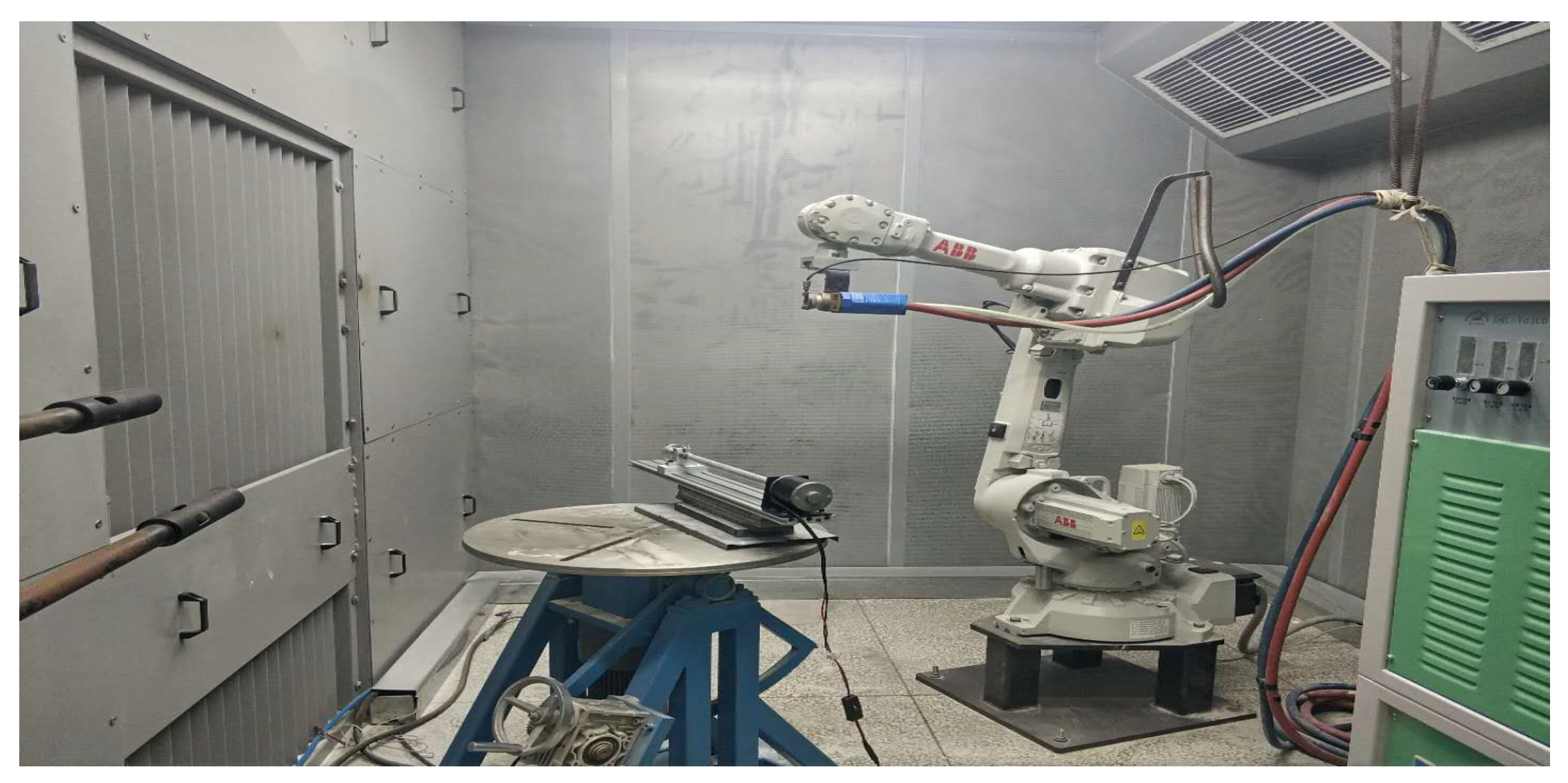


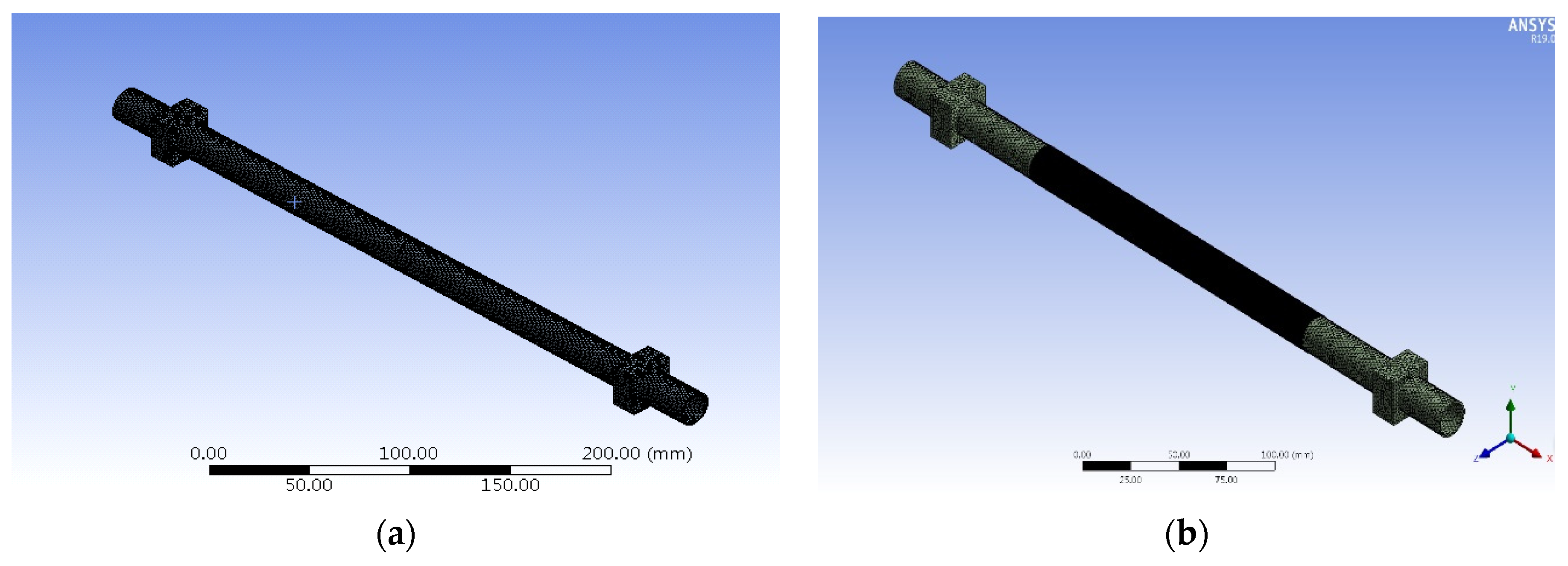

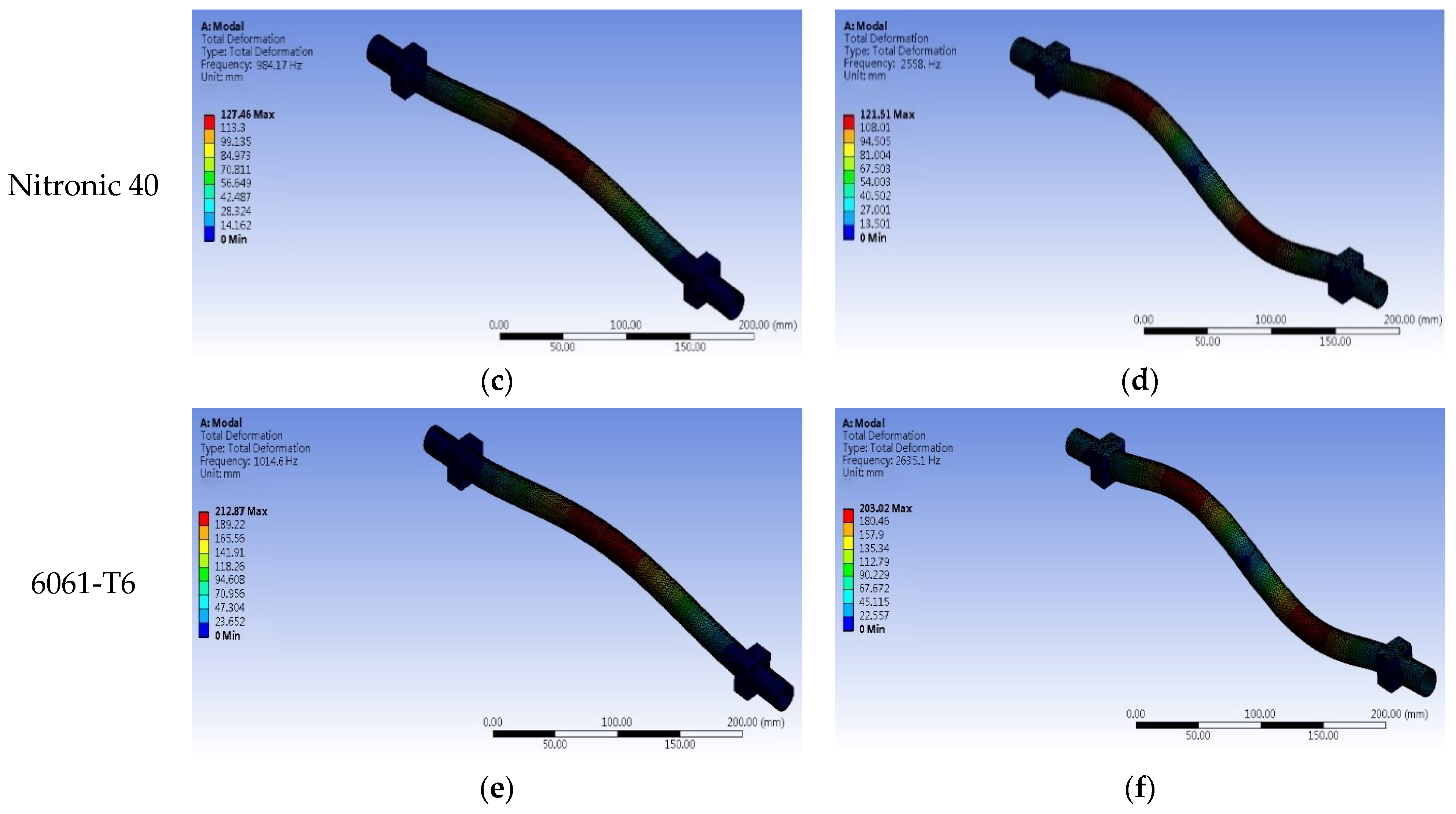
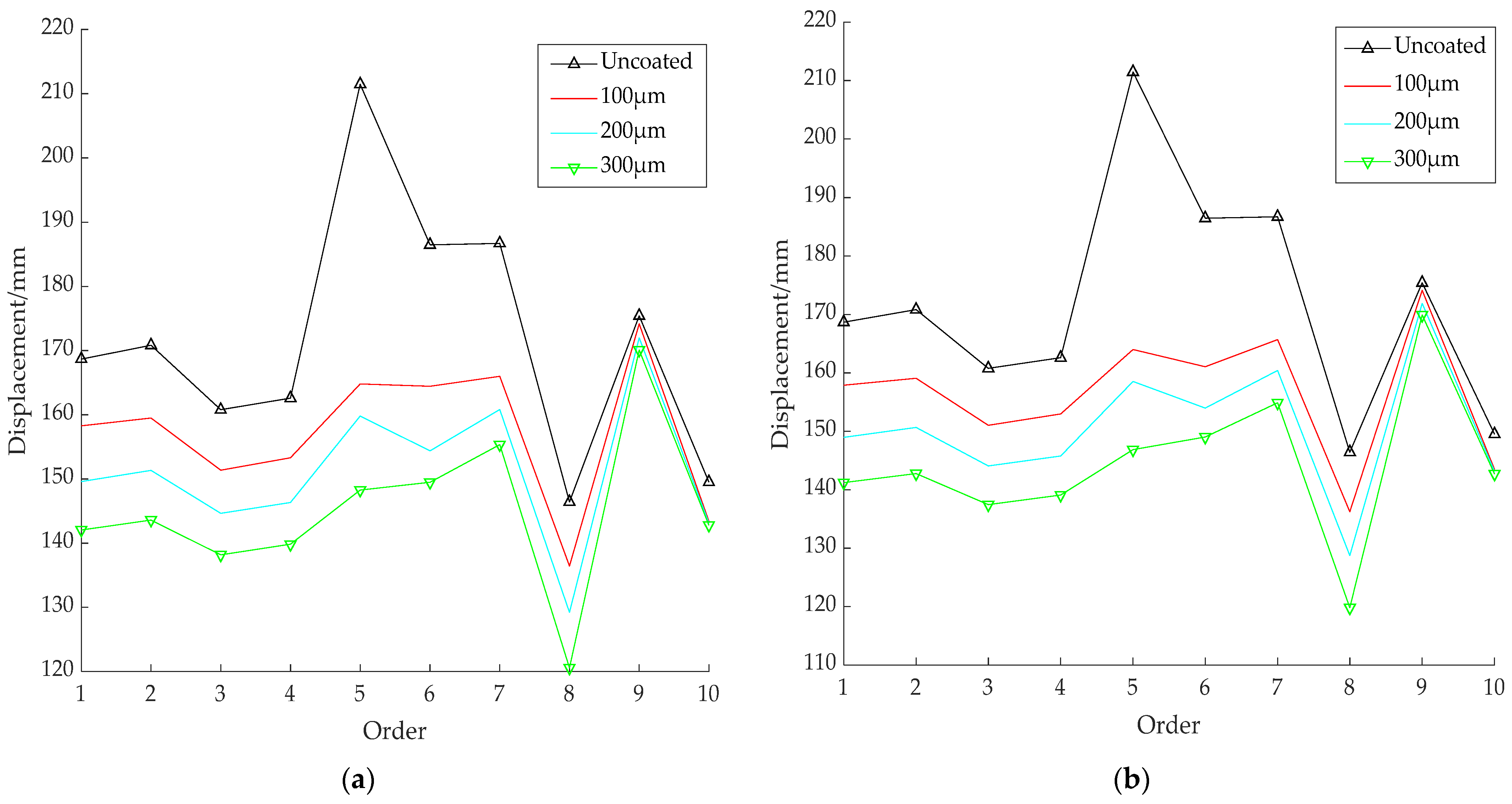


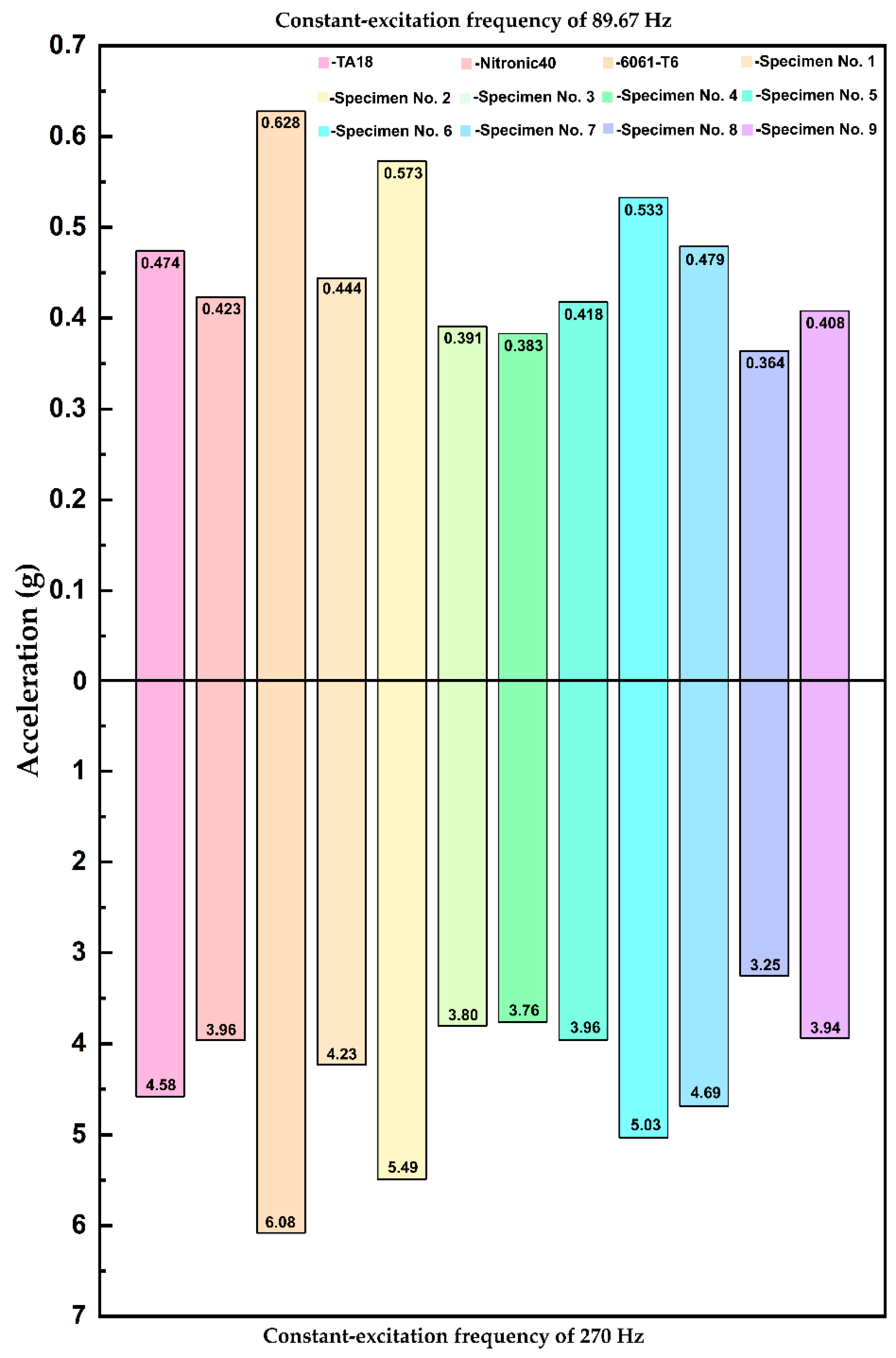





| Factor | Coating Thickness A (μm) | Coating Material B | Pipe Material C | |
|---|---|---|---|---|
| Level | ||||
| 1 | 100 | YSZ–PTFE | Titanium alloy | |
| 2 | 200 | Al–Cu–Fe–Cr | Stainless steel | |
| 3 | 300 | YSZ | Aluminium alloy | |
| Experiment Number | Horizontal Combination | Spray Thickness (A) | Spray Material (B) | Pipe Material (C) |
|---|---|---|---|---|
| 1 | A1B1C1 | 1 (100 µm) | 1 (YSZ-PTFE) | 1 Titanium alloy |
| 2 | A1B2C3 | 1 (100 µm) | 2 (Al-Cu-Fe-Cr) | 3 Aluminium alloy |
| 3 | A1B3C2 | 1 (100 µm) | 3 (YSZ) | 2 Stainless steel |
| 4 | A2B2C2 | 2 (200 µm) | 2 (Al-Cu-Fe-Cr) | 2 Stainless steel |
| 5 | A2B3C1 | 2 (200 µm) | 3 (YSZ) | 1 Titanium alloy |
| 6 | A2B1C3 | 2 (200 µm) | 1 (YSZ-PTFE) | 3 Aluminium alloy |
| 7 | A3B3C3 | 3 (300 µm) | 3 (YSZ) | 3 Aluminium alloy |
| 8 | A3B1C2 | 3 (300 µm) | 1 (YSZ-PTFE) | 2 Stainless steel |
| 9 | A3B2C1 | 3 (300 µm) | 2 (Al-Cu-Fe-Cr) | 1 Titanium alloy |
| Material | Working Gas | Current (A) | Power (Kw) | Distance (mm) | Line Speed (mm/min) | Average Particle Size (μm) |
|---|---|---|---|---|---|---|
| YSZ–PTFE | (99.9%) H2, Ar | 600 | 30 | 120 | 800 | 30–50 |
| Al–Cu–Fe–Cr | (99.9%) H2, Ar | 600 | 30 | 120 | 800 | 30–40 |
| YSZ | (99.9%) H2, Ar | 600 | 30 | 120 | 800 | 50–65 |
| Material | Density (kg × m−3) | Elastic Modulus (GPa) | Poisson’s Ratio |
|---|---|---|---|
| Nitronic40 (XM-10) S21900 stainless steel | 7830 | 180.643 | 0.298 |
| 6061-T6 aluminium alloy | 2810 | 68.9 | 0.33 |
| TA18 titanium alloy | 4470 | 123 | 0.291 |
| Material | Length (mm) | Density (kg × m−3) | Elastic Modulus (GPa) | Poisson’s Ratio |
|---|---|---|---|---|
| YSZ–PTFE | 400 | 5633 | 169.4 × 109 | 0.32 |
| Al–Cu–Fe–Cr | 400 | 4492 | 168 × 109 | 0.23 |
| YSZ | 400 | 5850 | 180 × 109 | 0.31 |
| Order | Uncoated | 100 (μm) | 200 (μm) | 300 (μm) |
|---|---|---|---|---|
| 1 | 1019.9 | 988.71 | 976.95 | 945.68 |
| 2 | 1049.7 | 1026.6 | 1004.3 | 985.92 |
| 3 | 2651.2 | 2643.1 | 2634.0 | 2621.8 |
| 4 | 2753.8 | 2736.7 | 2729.9 | 2715.1 |
| 5 | 4851.7 | 4693.7 | 4543.3 | 4392.1 |
| 6 | 4928.3 | 4936.9 | 4966.1 | 4972.1 |
| 7 | 5062.7 | 5085.5 | 5087.3 | 5087.4 |
| 8 | 6681.0 | 6494.5 | 6435.6 | 6297.1 |
| 9 | 7741.2 | 7788.0 | 7870.0 | 7914.7 |
| 10 | 8072.2 | 8100.8 | 8027.1 | 8017.8 |
| Order | Uncoated | 100 (μm) | 200 (μm) | 300 (μm) |
|---|---|---|---|---|
| 1 | 1019.9 | 988.69 | 976.88 | 959.64 |
| 2 | 1049.7 | 1026.5 | 1004.2 | 985.77 |
| 3 | 2651.2 | 2645.4 | 2637.7 | 2626.2 |
| 4 | 2753.8 | 2739.1 | 2733.5 | 2719.5 |
| 5 | 4851.7 | 4691.0 | 4537.1 | 4382.3 |
| 6 | 4928.3 | 4942.6 | 4974.9 | 4982.9 |
| 7 | 5062.7 | 5090.9 | 5096.0 | 5098.0 |
| 8 | 6681.0 | 6492.7 | 6429.9 | 6286.8 |
| 9 | 7741.2 | 7797.4 | 7886.2 | 7935.9 |
| 10 | 8072.2 | 8107.0 | 8038.1 | 8033.0 |
| Order | Uncoated | 100 (μm) | 200 (μm) | 300 (μm) |
|---|---|---|---|---|
| 1 | 168.68 | 158.28 | 149.61 | 142.06 |
| 2 | 170.83 | 159.48 | 151.33 | 143.61 |
| 3 | 160.78 | 151.38 | 144.65 | 138.18 |
| 4 | 162.59 | 153.30 | 146.34 | 139.83 |
| 5 | 211.48 | 164.80 | 159.80 | 148.28 |
| 6 | 186.47 | 164.43 | 154.38 | 149.50 |
| 7 | 186.70 | 165.99 | 160.82 | 155.35 |
| 8 | 146.43 | 136.44 | 129.23 | 120.57 |
| 9 | 175.42 | 174.18 | 171.99 | 170.08 |
| 10 | 149.52 | 143.41 | 143.12 | 142.81 |
| Order | Uncoated | 100 (μm) | 200 (μm) | 300 (μm) |
|---|---|---|---|---|
| 1 | 168.68 | 157.90 | 148.96 | 141.22 |
| 2 | 170.83 | 159.09 | 150.66 | 142.76 |
| 3 | 160.78 | 151.04 | 144.08 | 137.45 |
| 4 | 162.59 | 152.96 | 145.77 | 139.10 |
| 5 | 211.48 | 163.98 | 158.53 | 146.86 |
| 6 | 186.47 | 161.06 | 153.96 | 149.03 |
| 7 | 186.70 | 165.69 | 160.4 | 154.90 |
| 8 | 146.43 | 136.24 | 128.73 | 119.82 |
| 9 | 175.42 | 174.14 | 171.89 | 169.90 |
| 10 | 149.52 | 143.46 | 143.17 | 142.72 |
| Acceleration Response (g) | ||
|---|---|---|
| Experiment number | Excitation frequency 89.67 Hz | Excitation frequency 270 Hz |
| 1 | 0.444 | 4.23 |
| 2 | 0.573 | 5.49 |
| 3 | 0.391 | 3.80 |
| 4 | 0.383 | 3.76 |
| 5 | 0.418 | 3.96 |
| 6 | 0.533 | 5.03 |
| 7 | 0.479 | 4.69 |
| 8 | 0.364 | 3.25 |
| 9 | 0.408 | 3.94 |
| Parameter | Configuration | Parameter | Configuration |
|---|---|---|---|
| Sensitivity | 100 mv/g | Mounting thread | M5 |
| Frequency range | 0.5–9000 Hz | Resonant frequency | >25 kHz |
| Measuring range | 50 g | Resolution | 0.002 m/s2 |
| Weight | 10 g | Dimensions | 13 × 22 mm2 |
| Experiment Number | Spray Thickness (μm) (A) | Spray Material (B) | Pipe Material (C) | Vibration Reduction Rate |
|---|---|---|---|---|
| 1 | 1 (100 μm) | 1 (YSZ–PTFE) | 1 Titanium alloy | 6.03% |
| 2 | 1 (100 μm) | 2 (Al–Cu–Fe–Cr) | 3 Aluminium alloy | 4.60% |
| 3 | 1 (100 μm) | 3 (YSZ) | 2 Stainless steel | 1.63% |
| 4 | 2 (200 μm) | 2 (Al–Cu–Fe–Cr) | 2 Stainless steel | 11.95% |
| 5 | 2 (200 μm) | 3 (YSZ) | 1 Titanium alloy | 9.56% |
| 6 | 2 (200 μm) | 1 (YSZ–PTFE) | 3 Aluminium alloy | 12.95% |
| 7 | 3 (300 μm) | 3 (YSZ) | 3 Aluminium alloy | 19.98% |
| 8 | 3 (300 μm) | 1 (YSZ–PTFE) | 2 Stainless steel | 20.33% |
| 9 | 3 (300 μm) | 2 (Al–Cu–Fe–Cr) | 1 Titanium alloy | 15.56% |
| K1 | 12.26% | 39.31% | 31.15% | - |
| K2 | 34.46% | 32.11% | 33.91% | - |
| K3 | 55.87% | 31.17% | 37.53% | - |
| R | 43.61% | 8.14% | 6.38% | - |
| Excellent solution | A3 | B1 | C3 | - |
| Experiment Number | Spray Thickness (μm) (A) | Spray Material (B) | Pipe Material (C) | Vibration Reduction Rate |
|---|---|---|---|---|
| 1 | 1 (100 μm) | 1 (YSZ-PTFE) | 1 Titanium alloy | 6.71% |
| 2 | 1 (100 μm) | 2 (Al-Cu-Fe-Cr) | 3 Aluminium alloy | 6.50% |
| 3 | 1 (100 μm) | 3 (YSZ) | 2 Stainless steel | 3.83% |
| 4 | 2 (200 μm) | 2 (Al-Cu-Fe-Cr) | 2 Stainless steel | 6.92% |
| 5 | 2 (200 μm) | 3 (YSZ) | 1 Titanium alloy | 9.26% |
| 6 | 2 (200 μm) | 1 (YSZ-PTFE) | 3 Aluminium alloy | 10.10% |
| 7 | 3 (300 μm) | 3 (YSZ) | 3 Aluminium alloy | 26.25% |
| 8 | 3 (300 μm) | 1 (YSZ-PTFE) | 2 Stainless steel | 26.60% |
| 9 | 3 (300 μm) | 2 (Al-Cu-Fe-Cr) | 1 Titanium alloy | 10.19% |
| K1 | 17.04% | 43.41% | 26.16% | - |
| K2 | 26.28% | 23.61% | 37.35% | - |
| K3 | 63.04% | 39.34% | 42.85% | - |
| R | 46.00% | 19.8% | 16.69% | - |
| Excellent solution | A3 | B1 | C3 | - |
| 89.67 Hz | 270 Hz | |||||
|---|---|---|---|---|---|---|
| Experiment Number | Simulation Results (g) | Experimental Results (g) | Deviation | Simulation Results (g) | Experimental Results (g) | Deviation |
| 1 | 0.444 | 0.452 | 1.77% | 4.23 | 4.03 | 4.96% |
| 2 | 0.573 | 0.582 | 1.55% | 5.49 | 5.59 | 1.79% |
| 3 | 0.391 | 0.421 | 7.13% | 3.80 | 3.84 | 1.04% |
| 4 | 0.383 | 0.377 | 1.59% | 3.76 | 3.71 | 1.35% |
| 5 | 0.418 | 0.435 | 3.91% | 3.96 | 3.92 | 1.02% |
| 6 | 0.533 | 0.531 | 0.38% | 5.03 | 5.37 | 0.63% |
| 7 | 0.479 | 0.488 | 1.84% | 4.69 | 4.41 | 6.35% |
| 8 | 0.364 | 0.341 | 6.74% | 3.25 | 2.93 | 10.9% |
| 9 | 0.408 | 0.406 | 0.49% | 3.94 | 3.88 | 1.55% |
Publisher’s Note: MDPI stays neutral with regard to jurisdictional claims in published maps and institutional affiliations. |
© 2022 by the authors. Licensee MDPI, Basel, Switzerland. This article is an open access article distributed under the terms and conditions of the Creative Commons Attribution (CC BY) license (https://creativecommons.org/licenses/by/4.0/).
Share and Cite
Cui, Z.; Yu, X.; Ran, Z.; Liu, J.; Li, C.; Gao, L. Vibration Reduction Characteristics and Vibration Control of Aviation Hydraulic Pipeline by Hard Coating. Coatings 2022, 12, 775. https://doi.org/10.3390/coatings12060775
Cui Z, Yu X, Ran Z, Liu J, Li C, Gao L. Vibration Reduction Characteristics and Vibration Control of Aviation Hydraulic Pipeline by Hard Coating. Coatings. 2022; 12(6):775. https://doi.org/10.3390/coatings12060775
Chicago/Turabian StyleCui, Zhining, Xiaoguang Yu, Ziqing Ran, Jiaming Liu, Chunqiu Li, and Lei Gao. 2022. "Vibration Reduction Characteristics and Vibration Control of Aviation Hydraulic Pipeline by Hard Coating" Coatings 12, no. 6: 775. https://doi.org/10.3390/coatings12060775
APA StyleCui, Z., Yu, X., Ran, Z., Liu, J., Li, C., & Gao, L. (2022). Vibration Reduction Characteristics and Vibration Control of Aviation Hydraulic Pipeline by Hard Coating. Coatings, 12(6), 775. https://doi.org/10.3390/coatings12060775





